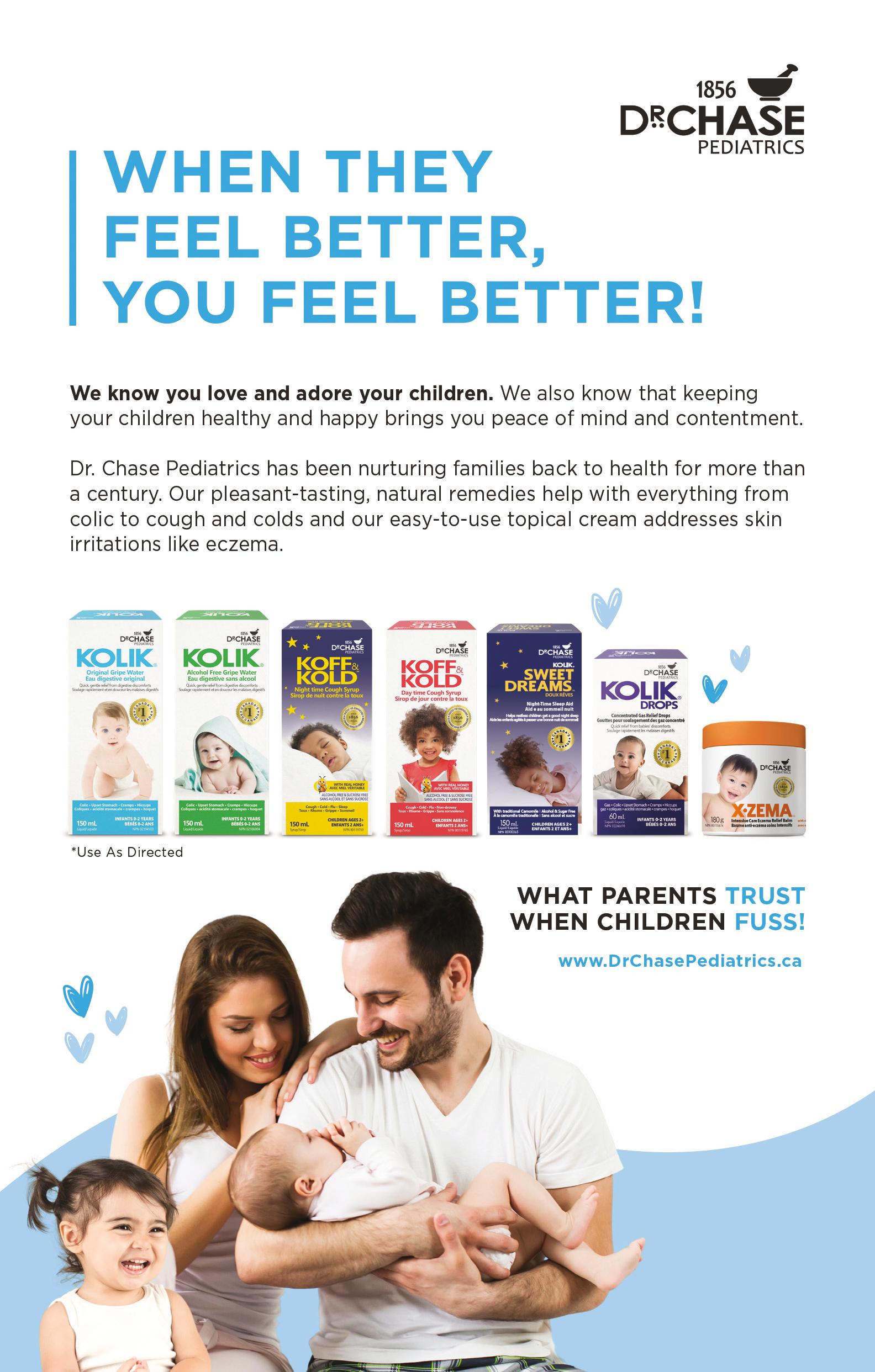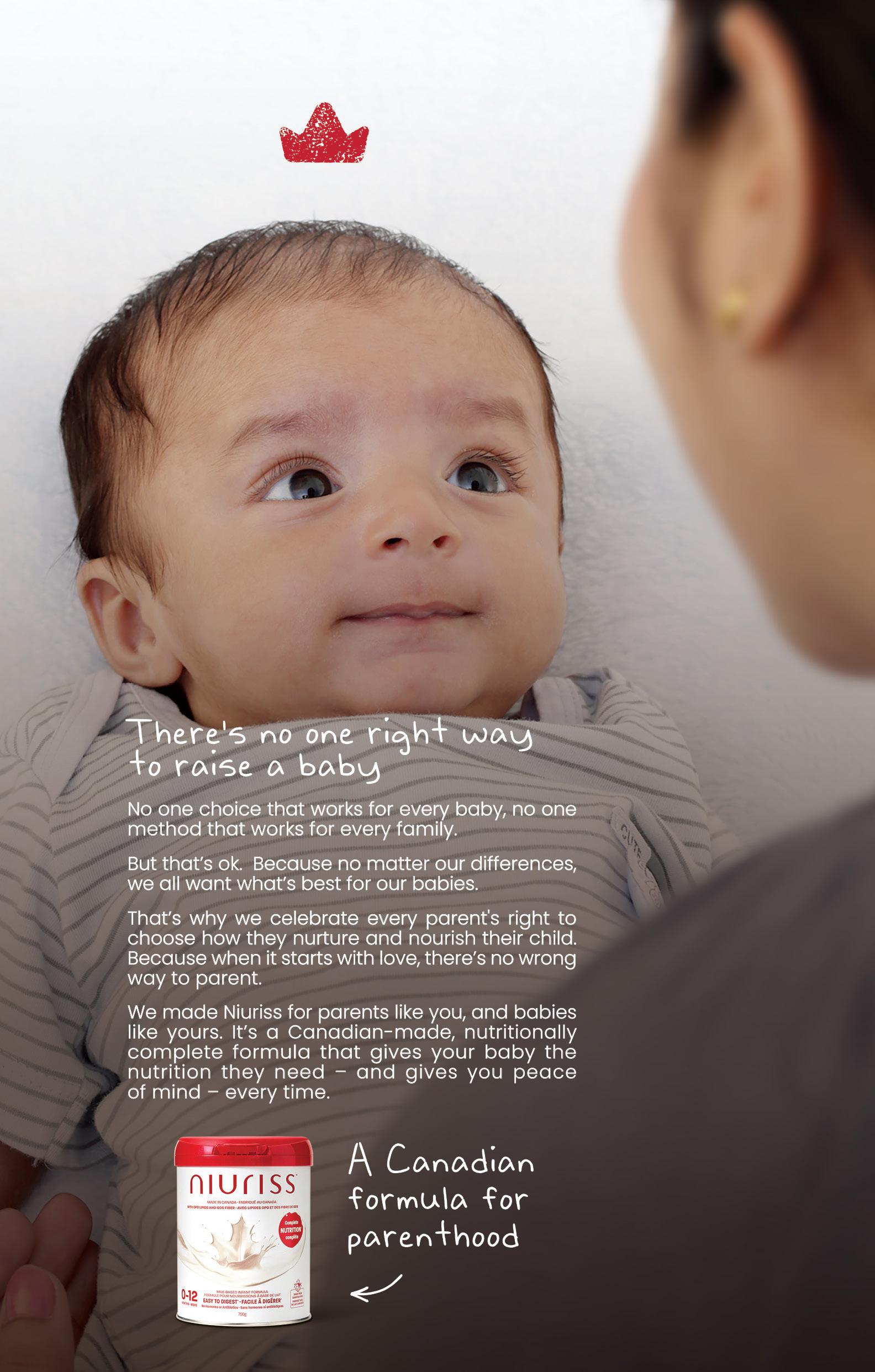








hether you’re eagerly awaiting your new addition or navigating the first year of parenthood, it’s an exciting time for families. But it can also be an overwhelming, exhausting and confusing time, too. We’ve been there—we get it.
Our aim with this magazine is to give you the information and answers you need so you can focus more on the joy and less on the stress. Think of it as your trusty companion for pregnancy and the first year, packed with tips, tricks and encouragement to help ease your anxiety and even make you laugh here and there. (Raising kids comes with more comedic material than you know!)
Parenting is hard. There’s no denying that. But it’s also really incredible. You’ll see. Just as soon as you get some sleep (check on page 37 for more on that particular subject!).
We’re always here for you at ParentsCanada, with guidance you can trust. Start with this magazine, and then come check out parentscanada.com for so much more.
The ParentsCanada Team
EXECUTIVE EDITOR
ART DIRECTOR
CONTRIBUTING EDITOR
DIRECTOR OF SALES AND MARKETING
CONTROLLER
DIGITAL DIRECTOR
CONTRIBUTING WRITERS
Katie Dupuis
Dawn Cumby-Dallin
Lisa van de Geyn
Lori Dickson
Lisa Mackay
Shardae Lang
Sadiya Dendar
Lisa Evans
Julie M. Green
Alanna McGinn
Karon West
OWNER/PUBLISHER
Jane Bradley
WWW.PARENTSCANADA.COM

Copyright © 2024 Jane Media Inc. The ParentsCanada Annual is a registered trademark of Jane Media Inc.
All rights reserved. The use of any part of this publication, reproduced, transmitted in any form or by any means electronic, mechanical, photocopying, recording, or otherwise, or stored in a retrieval system without the prior written consent of the publisher—or in the case of photocopying or other reprographic copying, license from the Canadian Copyright Licensing Agency—is an infringement of the copyright law.
Printed and bound in Canada by Dollco Printing Inc.
Published in Canada by Jane Media Inc.
407 Iroquois Shore Rd., Suite 8, Oakville, ON L6H 1M3 Telephone: 905-334-6417
This project has been made possible in part by the Government of Canada.

BY KARON WEST
Nine months (well, actually, 40 weeks) of pregnancy can feel super abstract, especially when you don’t really know what’s going on inside you. Sure, you can compare your baby’s development to types of fruit or baked goods to understand their size, but it’s even cooler to know how your little one is busy growing and changing as the weeks go by. We put together this week-by-week look at your baby’s development, giving you a fun and engaging sneak peek at their growth every step of the way.
4 WEEKS The embryo is just visible. > Development of the chorionic villi, from which the placenta is formed. > Production of the hCG hormone (human chorionic gonadotropin), which stops menstruation from occurring.
5 WEEKS The beginning of the embryo’s nervous system becomes evident as a ridge of tissue that will develop into the brain and spinal cord. > Initial formation of the heart with faint beats. > The nose and cheeks begin to show under the eyes.
6 WEEKS The embryo grows to less than 1 cm in size. > The spinal cord, brain, ears and eyes have started to develop. > The internal organs (lungs, digestive system, kidneys) begin to appear. > Tiny buds of arms and legs take shape.
7 WEEKS The major organs develop. > Distinct facial features appear with skin covering the eyes. > Definable arms and legs are visible, with the emergence of developing fingers and toes. > The muscles, bones and blood vessels begin to develop. > The heart of the tiny embryo beats rapidly, at about 160 beats per minute.
8 WEEKS All of the major organs are nearly formed > The head is very large in proportion to the body, as rapid brain growth
occurs. > The embryo will now make slight movements and is approximately 2 cm long. > The amniotic sac fills about two-thirds of the uterus, sealing in the amniotic fluid that surrounds and protects the fetus.
12 WEEKS The rapidly developing embryo is now called a fetus.
9 TO 13 WEEKS By 12 weeks, the fetus is a recognizable human being. > Gender was determined at conception, but now the sex organs begin to differentiate into male or female organs. > The fetus starts exercising its muscles. > By the end of this trimester, the fetus is a tiny, fully formed human being, 7 ½ cm long, weighing approximately 1 ounce.
16 WEEKS The fetus is very active. > Fine, downy hair begins to grow over the delicate, semi-transparent skin. > Bone and circulatory growth continues rapidly. > Fingernails and toenails are present at this stage. > External genital organs are fully formed, and gender can be clearly distinguished.
20 WEEKS Fetus swallows amniotic fluid. > Kidneys produce fairly large quantities of urine, which is excreted into the amniotic fluid. > Hair appears on the scalp.
24 WEEKS At this stage, the fetus is termed viable (able to survive) and weighs about 1 to 1½ pounds. > There is very little body fat. > The skin is wrinkled and covered with a white, cheesy substance called vernix. This protects and lubricates the delicate skin. > You may now feel the baby’s movements.
28 WEEKS Your unborn child will spend the next few weeks laying down fat under their skin. > The body undergoes rapid growth; size becomes more proportionate to the head. > Hiccupping is common; you experience this as a gentle, rhythmic sensation. > The baby’s lungs are beginning to function.
32 WEEKS The baby weighs about 4 to 4½ pounds. > A baby born at this stage in pregnancy is likely to experience minimal negative effects, though they may need intensive neonatal care as they continue to grow.
36 TO 40 WEEKS A great deal of fat continues to be laid down under their skin. > Your infant’s lungs have matured significantly in preparation for survival outside the womb. > The vernix is shed, although some might still be present at birth. > At this stage, your child is fully developed, with the characteristic features of the newborn infant.
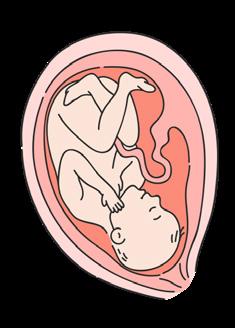





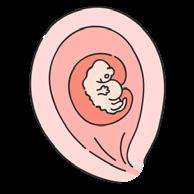




Creating a baby registry can be an exciting—and overwhelming— experience. Unsure of where to start? Here’s what you’ll actually need for your newest arrival.
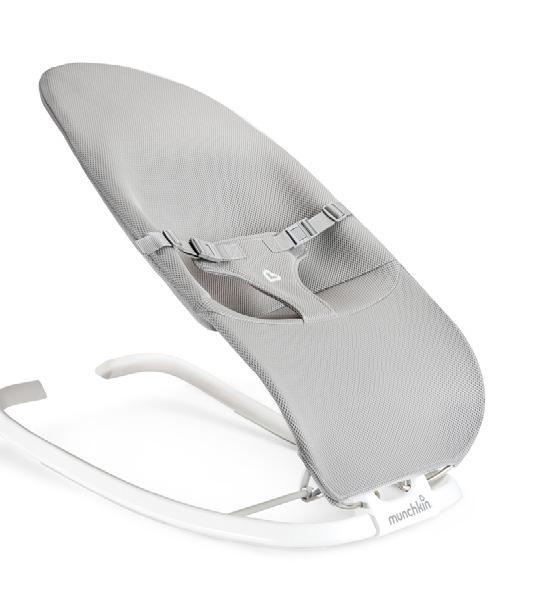
Munchkin ClearNose™ Nasal
Aspirator, $20.99
Babies average six to eight colds in their first year, and there’s nothing worse than a little one who is congested and unable to sleep. So, trust us when we say you’ll be reaching for this device often. This filter-free aspirator comes with three different nasal tips, plus it’s easy to use and stays clean and contained in a compact storage case.
Munchkin 2-in-1 Baby Bouncer and Rocker, $189.99
This lightweight lounger pulls double duty thanks to its ability to gently bounce or rock your infant. Choose from one of three recline positions to ensure a safe and cosy environment. Parents with their hands full will love the one-step assembly and the fold-flat design for easy storage. Bonus: The sleek design means you don’t have to compromise on style.

Munchkin Shhh…™ Baby Shusher, $29.99
Munchkin Bristle™
Bottle Brush, $8.99
The amount of washing up that a baby creates is absolutely amazing, so we’re all for products that help get the job done faster and better. This bottle brush features a patented suction cup base, so it stays upright and clean on the counter. It also features a textured, easy-grip handle, and the nylon bristles are durable yet scratch-free for a thorough but gentle clean.
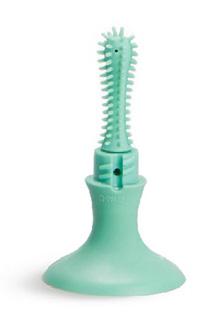

Your baby just spent nine months in the womb surrounded by ambient sounds, so it’s no wonder that they love background noise. As they adjust to life in the world, the low hum of certain sounds (like the vacuum or your stove’s exhaust fan) can actually be comforting to a newborn. This portable machine does one better: It plays three sounds (shushing, a heartbeat and white noise) to help calm your baby and aid their sleep. It comes with batteries (no need for another charger!) and includes a convenient nightlight and timer.

Munchkin Bluetooth-Enabled Lightweight Baby Swing, $249.99
This lightweight swing gently sways from side-to-side, just like a parent would. Designed for babies from five to 20 pounds who cannot sit up or climb out, it’s simple to both set up and store, so it can be easily tucked away or toted along for a weekend at Grandma’s. The touchscreen display allows you to choose from five speeds (or you could use the included remote instead!). Pair the swing with your smartphone and play baby’s favourite lullabies.
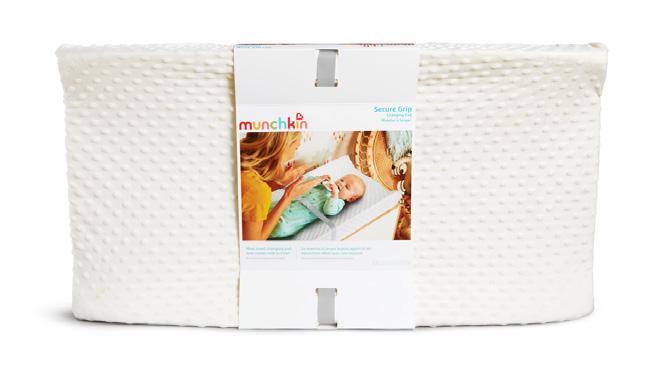
Munchkin TheraBurpee™ Colic & Fever Rescue Kit, $29.99
A little cuddle can go a long way, but this clever kit takes it to the next level. Help ease discomfort caused by teething, fever or colic with these premium burp cloths that hold fabric-covered gel packs for hot or cold therapy. Designed by a certified medical massage practitioner and mom of four, these double-duty cloths can also provide relief for nursing pain caused by blocked ducts.

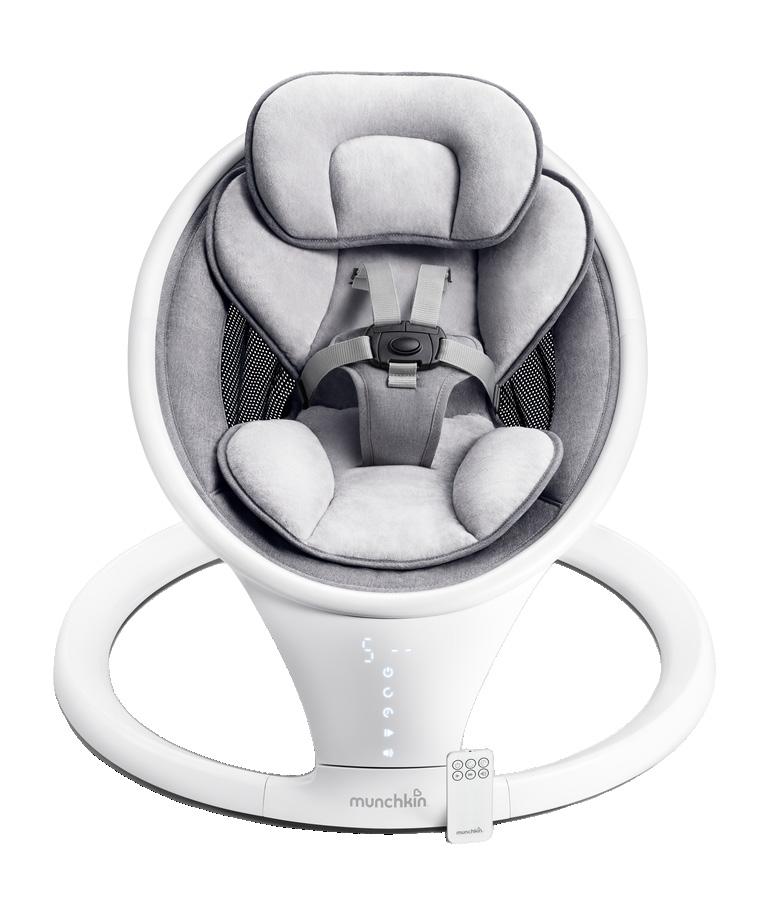
Secure
We hate to break it to you, but if you find newborns to be wriggly creatures, they only get squirmier. That’s why we love this waterproof change pad: Not only does it wipe down quickly, but it features a safety strap and rubber strips for extra grip. The soft contoured cushion keeps your little one cozy and fits most change tables, dressers and change pad covers.
You’ll want to keep an eye on your most precious cargo while in the car, and this wide-angle adjustable mirror will give you the clearest sightline. The easyto-install accessory securely attaches to adjustable vehicle headrests and is shatter resistant and crash-tested. It features four glare-free LED lights on the lower third of the mirror to help illuminate your baby, or to entertain or soothe them. It’s easy to control thanks to the remote with a timer.
Munchkin Touch-Free Baby Wipe Warmer with Nightlight and Motion Sensor, $69.99
Sure, nighttime diaper changes aren’t the most glamorous part of the parenting gig, but this nifty gadget will make life easier for both parties. Not only does it warm wipes for more comfortable cleanup, but it also offers a touchless motion-sensor lid that automatically opens and closes so there’s less to disinfect. Also, the built-in nightlight provides a soft glow to give visibility but also keep the room dark during changing (it automatically turns off after 15 minutes!).



What’s normal: It’s normal to have bleeding, similar to a heavy period, for up to six weeks. The lining of the uterus is shedding, so it might be heavy early on but it should get lighter over the next few weeks. You may also experience increased bleeding and pain similar to contractions while breastfeeding, as nursing stimulates oxytocin, which affects all of the smooth muscles in your body. This process is helping your uterus contract back to its pre-pregnancy size.
What’s not normal: Contact your doctor if you are soaking through a pad every hour, if you are passing clots greater than the size of a loonie or if you have foul-smelling discharge or a fever. It may be an infection or retained placenta.
We’re not going to lie—the days and weeks following childbirth aren’t always super pleasant. (The good news? Your new bundle will likely keep your focus off any soreness or discomfort.)
Wondering what you could experience postpartum? Here’s what’s most common.
What’s normal: Many women tear or have an episiotomy during delivery, so it’s common for the area to be sore and uncomfortable for up to a few weeks (you likely have stitches, so this makes sense!). Use a peri bottle filled with water after urination or bowel movements to keep the area clean. Some women use ice packs (or maxi pads soaked in water and frozen), especially 24 to 72 hours after delivery, to help bring down the swelling. It’s also recommended to sit on a donut pillow and use a stool softener to stay ahead of the pain.
What’s not normal: If you’ve taken Tylenol or Advil and you still have substantial pain, or if the pain gets worse, call your doctor.
What’s normal: It is very common for women to develop hemorrhoids during pregnancy or during the delivery. Basically, intra-abdominal pressure forces veins to swell and stretch around the anal area. You can treat the symptoms of pain, itching and discomfort by taking regular, 10-minute sitz baths (a shallow bath with warm water). Also be sure to drink lots of water and eat a high-fibre diet to avoid straining. You can also apply witch hazel, which is soothing, or use an over-the-counter product containing hydrocortisone and zinc oxide.
What’s not normal:

Up to 10 percent of women may develop postpartum depression, which can appear anytime within 12 months of delivery.
see an improvement fairly quickly. If you have sore nipples, lanolin or other cream developed for nipples can help, but you should also see a lactation consultant to see if you can tweak your nursing techniques or positions. Otherwise, the pain will worsen.
post-birth hormones and it usually starts during the first postpartum week. It can last for a few days up to a few weeks. Rely on the support of your friends and family to get through it.
For many women, hemorrhoids will eventually go away, but others will have them long term. Consult with your doctor if you’re bleeding or are in a lot of pain.
What’s normal: After delivery, your breasts will fill with milk and become engorged. Often, it is difficult for newborns to help relieve the engorgement because they can’t yet suck hard enough. Some babies also have trouble latching, which can cause moms to have bleeding or cracked nipples. For engorgement, use Tylenol or Advil to treat the pain (cool compresses and even cabbage leaves can also help) but you’ll also need to relieve the pressure: Try hand-expressing or pumping and you should
What’s not normal: Call your doctor if your breast is sore, hard and red, or if you have a fever. It could be an infection called mastitis and you may need antibiotics.
What’s normal: Follow your doctor’s directions to care for your C-section scar. Once the staples come out, you will likely get steri-strip bandages, which you should leave on for as long as your doctor advises. When you remove them, keep the area clean by gently cleansing with soap and water.
What’s not normal: If your scar is an angry colour of red, oozing or smelly, contact your doctor.
What’s normal: Forty to 80 percent of women will develop what’s commonly called “the baby blues.” This is normal. This mood issue is related to the change in
What’s not normal: Up to 10 percent of women may develop postpartum depression, which can appear anytime within 12 months of delivery. If you experience consistent sadness or anxiety, or are having trouble caring for your baby, see your doctor. Anxiety can be common, but if it interferes with eating and sleeping and you are agitated all the time, take it as a warning sign. It can be treated with a range of therapies including individual therapy, group therapy or medication. Women who have had postpartum depression before are more likely to experience it again. PC


BY DR. COURTNEY MANSER
For most pregnant women, getting a great sleep is easier said than done. Find out what’s going on inside your body and what you can do to make peace with your pillow.
pregnancy can turn sleep into a tricky game. Excitement and anticipation are running high, and your belly buddy may have an agenda of their own (hiccups, anyone?). Add in the physical discomforts that come with growing a human and getting a good night’s rest can feel like an elusive prize. Read on for some of the reasons sleep might be hard to come by, and what you can do about them.
During pregnancy, the ligaments in your body become looser so that
your uterus can expand and eventually allow your baby to fit through your pelvis during delivery. This causes achy joints. Once you add the weight of the baby to the mix, your back is begging for a break. Frequent stretching can relieve some of this pain; round your back around your bump with your chin and knees tucked in, hold for a few seconds, then release. Finish by placing your hands on your lower back and arch slowly.
Body pillows that support your bump and upper leg can take the pressure off
your lower back at night. Acetaminophen, as opposed to ibuprofen, is safe to take for pain.
The physiological reason for leg cramps is complicated and not well understood, but it can involve low calcium and high phosphate levels. The added weight of pregnancy and inadequate potassium intake may also play a part. If you drink a lot of milk, try cutting back. Although milk contains high levels of calcium, it is also rich in phosphates. Try eating potassium-

rich foods such as baked potatoes, avocados, spinach or bananas. Also, keep wellhydrated and stretch your legs before bed and when you wake up. Do not take any vitamin supplements unless on the recommendation of your physician.
At night, you may become short of breath when lying flat on your back or even on your right side. This is because a large vein called the inferior vena cava runs up the right side of your abdomen to your heart. Lying on your back or right side can sometimes obstruct this vesicle, leading to
diminished blood flow back to your heart, causing shortness of breath. Try lying on your left side with your back extended. Always tell your physician if you experience shortness of breath, too; this may be a sign of a more serious condition.
You may have noticed you’re urinating more frequently. Even in early pregnancy, the blood flow to your kidneys increases, resulting in frequent urination. Decrease the amount of drinks that act as a diuretic, such as coffee and tea. Also, lean forward when you pee to ensure you
have completely voided at each bathroom visit.
Your enlarged uterus places pressure on your stomach and increases the time it takes for your stomach to empty. Also, the valve between your stomach and esophagus becomes more lax, allowing food and acid to travel up into your esophagus. Try not to eat at least two hours before bed. Avoid caffeine (including chocolate—sorry!), spicy foods and greasy/fatty foods as much as possible. Sleep with two pillows to elevate your head and to help prevent stomach acid from going rogue.

BY LISA VAN DE GEYN
We know what’s on your mind but give those googling thumbs a break. We took the liberty of providing you with the answers you’re looking for. Spoiler alert: There are two poop questions and one about sex. You’re welcome.
1
“Do I need to eat for two?”
No, you don’t need to double your meals. According to the Society of Obstetricians and Gynaecologists of Canada, you need to up your calories only in your second and third trimesters (an extra 340 calories each day in second trimester, and 450 calories per day in third). You can easily meet the requirement by adding a snack or two—have a piece of fruit, yogurt, cheese, a piece of toast or something else you’re craving.
“Why is my partner ticking me off?”

your days. Your healthcare provider can recommend a stool softener, too.
“What can I do about swollen ankles?”
We understand. Pregnant folks are super hormonal and that can certainly affect our emotions, making us irritable, impatient, easily aggravated, livid…you get the idea. Try not to be hard on yourself (or your partner). Psychologists recommend making time for self-care and if you feel your better half isn’t being as supportive as you need, share your feelings using as many rude polite words as you can muster.
Cankles are highly unpleasant. Swollen ankles are normal (and annoying), and they’re caused by a few things your body is dealing with when you’re pregnant, including extra fluid retention. Try not to stand for long periods of time, get into a swimming pool (walking in the water or doing laps can help), wear loose clothing, elevate your legs in bed and sleep on your left side. It’s uncomfortable now but it won’t last—your ankles (and feet) will return to their usual size after you deliver.
6
“How big is my baby now?”
Seeds, nuts, pieces of fruit— we all love making these comparisons when it comes to our growing babies. Most parents are interested in knowing what’s happening each week, but here’s a quick glance: At four weeks pregnant, your wee one is the size of a poppy seed; eight weeks, a raspberry; 12 weeks, a lime; 16 weeks, an avocado; 20 weeks, the length of a banana; 27 weeks, a head of cauliflower; 33 weeks, a pineapple; 39 weeks, a small watermelon; 40 weeks, a small pumpkin.
“Can my baby feel us when we’re having sex?”
Nah, you’re good. Get busy. Enjoy. Babies can’t feel a thing—they’re protected in amniotic fluid up in your uterus. Do it whenever you want, as long as your healthcare provider has given you the green light. (Some women are told to hold off at certain points of their pregnancies if they’re high risk.) PC
“How can I relieve constipation?”
7 2 3 4 5
Yeah, pooping isn’t always easy when you’re expecting—many women suffer from constipation. (It’s pretty crappy, pun intended.) Your best bet is to amp up your fluids (water is your BFF; prune juice also helps), increase your fibre intake and add an extra walk or more movement into
“Will I poop during labour?”
Ah, another poop question. The answer to this question is most likely, yes. And no one—we’re not kidding, no one—will bat an eye. Your doctor doesn’t care. Your nurses don’t care. And your partner and anyone else in the room won’t even notice. Nurses are like ninjas—you’ll be cleaned up in seconds.



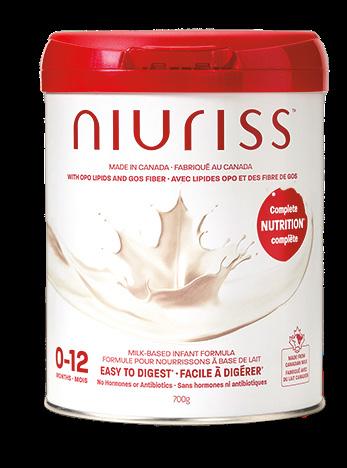
Most first-time parents expect breastfeeding to come naturally, but for some families, it’s anything but. Read on to learn more about what to consider when introducing formula, including smart tips from our friends at Niuriss.
Most expectant parents in Canada plan to breastfeed. In fact, according to data released by Statistics Canada for World Breastfeeding Week in 2022, a whopping 91 percent of new Canadian mothers surveyed initiated breastfeeding with their newborns.
This is great news, overall. Breastfeeding can provide major benefits for both mothers and babies. But things don’t always go to plan, and it can be extremely challenging for some families. Infants can experience things like tongue ties or poor latching, and mothers can have issues ranging from low milk supply to breast infections. If you come up against
these kinds of difficulties, there’s no shame in supplementing with or switching to formula.
For many people, it’s not about deciding between breastfeeding and formula feeding. It’s about being open to the idea that you may need to be flexible. Many new breastfeeding moms don’t know when they aren’t producing enough milk, for example, and they’re confused by babies who always seem to be hungry or can’t settle. Adding formula to the mix can help infants to feel satisfied, which can lead to less fussiness,
improved sleep and an overall easier time for new parents.
The bottom line is, if something isn’t working, consider a change. Ask your primary care team for guidance—your doctor, your child’s doctor or a public health nurse will all have insights into how to improve the feeding experience.
All formulas available in Canada meet the nutritional requirements set by Health Canada, so you really can’t go wrong. But, Niuriss is especially interesting because it’s the only infant formula made in Canada. This means it’s extremely reliable in light of recent formula shortages. Because it’s produced here, in a state-of-the-art facility, the company has the capacity to produce enough formula to meet the needs of the Canadian market.
Niuriss also provides top-quality infant nutrition that adheres to the highest global standards of quality and safety. It’s formulated using premium ingredients and locally sourced Canadian milk free from artificial growth hormones and antibiotics. Niuriss products are also first-to-market nationally to include OPO lipids, which are designed to closely resemble the fat structure of breast milk. This composition contributes to the overall well-being of babies who are being supplemented with or exclusively fed by formula. Niuriss is both kosher- and halal-certified.
Other benefits of Niuriss include the following:
• Support for calcium absorption and bone development
• Enhancement of fatty acid absorption for improved energy intake
• Growth of beneficial gut bacteria and strengthening intestinal protection
• Reduction in constipation, which results in less crying and better sleep
Many people feel that ready-to-feed formula is a better choice simply because it’s already mixed, but really, this is just about convenience. Ready-to-feed formats are often more expensive than powdered formats, and there’s no difference in nutritional benefit.


Once you’ve landed on a formula brand, next you’ll choose the format that works best for your family. Each format has to be approved by Health Canada, so again, whatever choice you make is safe.
Formula formats are available at a range of different price points. Admittedly, formula can put a significant dent in your weekly grocery budget, and while it can be tempting to go with whatever is on sale each week, consistency is better for your little one.
Niuriss knows the monetary challenge formula presents and is committed to helping new parents to manage their formula budget for the first year. That’s why they’ve created their Nest program, which offers price protections against cost increases. There are other Niuriss Nest member-exclusive perks, including deals for formula, shipping price breaks and more.
The first year after you welcome a new baby, whether this is your first or fifth, can be an exhausting, worrisome time. But take feeding out of the equation. There’s no right way or wrong way to feed your baby, so cut yourself some slack and place your worries somewhere else. And remember, ParentsCanada and Niuriss are here for you, every step of the way.

Many people think that pregnancy is a magical period in a soon-to-be parent’s life. That just isn’t the case for everyone.
Writer Sadiya Dendar
shares why she hated being pregnant, and why that’s absolutely fine.
you’re always told what a magical time pregnancy is. How exciting it is to see your little one at your first ultrasound, and, a couple of months later, feel their fluttery kicks. And oh, how you’ll glow.
So I was excited for this journey. I was excited to get a big belly and take prenatal classes and to experience it all. I wanted my kids to be close in age, and I wanted to baby-wear and get a stroller that would easily convert into a double. I wanted a cute little bassinet that would sit right next to my bed for six months, and then a beautiful ivory crib that the baby could use once they got a bit bigger. I wanted it all.
Until I got pregnant.
I thought it would take a couple of months to get pregnant, at the very least. Nope, just a couple of weeks after stopping the Pill, I started feeling light-headed, exhausted and nauseated. So, so nauseated.
Knowing my mom had suffered with morning sickness for the first few weeks with both of her pregnancies, I figured I’d be the same. But the morning sickness lasted all day. And all night. The faintest of smells would have me staggering to the nearest trash can.
And each day, wellmeaning moms told me it would get better:
“Don’t worry, as soon as the first trimester is done, you’ll feel okay.”
“Just wait until 15 weeks, then you’ll be fine.”
“Twenty weeks is the magic number. Once you reach the halfway point, it’ll be totally different.”
No, no and no. As each of these milestones approached, I’d wait to feel better. But nothing changed. Instead, I felt more and more down.
I had no appetite.
Strawberries would be okay for a bit—until I’d puke. Same with crackers. And everything else. The only thing that slightly quelled my nausea was ice cream and iced cappuccinos. My doctor didn’t care as long as I was eating something.
I moved back into my childhood bedroom with my parents so my mom could look after me. She did my laundry, made my bed, cooked things she thought I could stomach, and brought me glasses of water, ginger ale and juice in an attempt to keep me hydrated.
Other than going to work, I mostly stopped leaving the house. I didn’t want to sit in a car, I didn’t want to have to pretend to smile and I didn’t want to have to speak to people. Especially when I received comments like, “You know, you’re not the first woman to be pregnant and you won’t be the last” and, “You should be grateful that you’re even able to have a baby” and, “It’s just mind over matter.”
I felt like I was failing at every turn.
Besides the nausea and pretty severe depression, I also experienced terrible anxiety that affected my ability to sleep. I’d lie awake all night, unable to stop my mind from spiralling. I was terrified of labour. I thought about finances. What would happen once my mat leave ended. My aging parents. Looming deadlines at work. And all of the things I couldn’t do.
My incredibly supportive family physician gave up her lunch breaks once a week to check in with me until I could get an appointment with a maternal mental health team. Initially I’d met with a social worker to discuss my progress, but I finally got in with a psychiatrist just about a month before I was due. She decided things were bad enough to prescribe me antidepressants.
Nothing helped. And now I had something else to worry about: I had prenatal depression, so I was at higher risk of postpartum depression. How would I function taking care of a baby when I couldn’t take care of myself?
It was truly the longest and most trying period of my life.
My husband encouraged me to go on short-term disability to lessen my stress. My OBGYN agreed. But I felt like work at least forced me out of bed each day.
I would spend the weekends in bed feeling too tired and too nauseated to do much other than wander out to the deck a couple of times a day.
Because of other complications that I learned about in my third trimester, my doctor decided to induce me at 38 weeks. So I ended up taking maternity leave at 36 weeks.
Wrapping up work helped. I no longer had to worry about dragging myself out of bed early for the long commute into the city. Perhaps what helped most of all was the extra time I got to spend with my niece, who came over on the days my sister-in-law worked. She’d crawl into bed and snuggle up with me and stroke my face and tell me how much she loved me.
In the meantime, my mom did all the prep. She washed and ironed the baby clothes and packed them into a set of drawers. My husband, when he wasn’t working, buying me ice cream or installing the car seat, was trying to set up the nursery at home. We had decided we’d both stay with my parents for a few weeks after I gave birth for the extra sets of hands, but he wanted our house to be ready, too.
And I stressed about my induction and labour and how painful it would be and how early I could get an epidural. And what if I never felt okay again?
The day of my induction arrived and I had my phone
I’d lie awake all night, unable to stop my mind from spiralling. I was terrified of labour.
close by, waiting for a call from the hospital to let me know when they had a room free for me. The call finally came at 3 p.m.
Registering at the hospital felt strangely like checking into a hotel. We stood at the nurses’s desk and filled out forms, then we were shown our room and told where to put the hospital bag. I was given a gown and told to change and lie down in bed until someone was ready to see me. It felt so surreal.
Most first-time moms can expect to be in labour for 12 to 24 hours with their first baby—and often longer if you’re induced. But things progressed quickly. The contractions started and I was offered an epidural at three centimetres. I wasn’t sure about taking it because I didn’t want it to wear off before delivery, but my husband said to get it and see how it goes.
He was right. My entire labour and delivery lasted less than six hours. And the epidural worked like a charm. Unfortunately, once I started pushing, the baby’s heart rate began dropping. The doctor quickly realized the umbilical cord was wrapped
around his neck and the doctor used a vacuum to help deliver him.
The second he was out, my son was whisked away to get checked. I gave a big sigh and then I choked back tears. The doctor patted my leg and told me that the baby was going to be fine. I knew that. The real reason for my tears? I finally felt relief.
It was as if this dark shadow was lifted. The nausea was gone. I could smile again. I had things to say and I could laugh. My mom walked into the room and said she could tell I was back.
Once we got to our room, my husband asked me if I wanted to eat and I didn’t hesitate to ask for a bagel with cream cheese, a muffin and chocolate milk, which I gulped down pretty enthusiastically as soon as he handed it over.
That night, I couldn’t sleep, but it wasn’t because of pain or anxiety or a screaming babe. I was just so happy to be normal again. I enjoyed happiness, excitement and texting my friends. I quickly escaped the shell I had been shut in for the last nine months. And I had a healthy little baby to snuggle with.
And that postpartum depression? It didn’t appear. That doesn’t mean it was easy. Sleep deprivation, nursing and never having a minute to shower was tough. But, for me, pregnancy was tougher, and I was so happy to be on the other side of it. PC
BY LISA EVANS
No one really knows what’s going to happen during labour and delivery, but be rest assured your healthcare provider has likely seen it all. Your best bet? Go into this process knowing childbirth can be unpredictable, and trust the experts. You’ve got this!

Despite having a birth plan, labour and delivery can be unpredictable, and unexpected things can happen despite all of your careful planning.
Here are some of the unexpected labour and delivery occurrences you could experience:
Labour dystocia: Labour dystocia occurs when labour stalls or progresses slowly, making it difficult for the baby to move through the birth canal. This can result in prolonged labour, and may necessitate interventions, such as assisted vaginal delivery or Cesarean section.
Fetal distress: This refers to signs that the baby is not receiving enough oxygen during labour. It can occur due to umbilical cord compression, placental abruption or prolonged labour. Fetal distress
may require emergency interventions, such as changing positions or an emergency Cesarean section.
Shoulder dystocia: Shoulder dystocia occurs when the baby’s shoulders become stuck behind the mother’s pubic bone during delivery. This can be a medical emergency that requires immediate intervention to prevent injury to the baby and mother.
Perineal tears: These tears are common during vaginal delivery, especially for firsttime mothers. While some tears are minor and may heal on their own, others may require stitches or more extensive repair.
Postpartum hemorrhage: This is categorized as excessive bleeding after childbirth and can occur due to factors such as uterine atony (failure of the uterus to contract), retained placental
tissue or lacerations. Immediate intervention is necessary to control bleeding and prevent complications.
Infection: Endometrial or wound infections can occur following childbirth, particularly after Cesarean section or prolonged labour.
Preeclampsia or eclampsia: Preeclampsia is a pregnancy complication characterized by high blood pressure and signs of damage to other organ systems. Eclampsia involves seizures in addition to preeclampsia symptoms. These conditions can pose serious risks to both the mother and baby, and may require urgent medical treatment.
Unplanned Cesarean section: Despite planning for a vaginal delivery, some women may require an unplanned Cesarean section. PC
BY JULIE M. GREEN

Don’t judge a little baby fat.
My son was a cry baby, literally. In the early weeks of his life, he cried—nay, wailed, screeched, howled—so much that my healthcare worker concluded he must be hungry. It being England, she said, “Maybe the wee lad needs a wee bit more to eat.” And me being a first-time mom, in a foreign land to boot, I deferred to her advice.
ut, because I wasn’t able to breastfeed successfully, a special formula for my insatiable baby boy was recommended.
And eat he did.
Over the weeks, more skin folds and dimples appeared. My baby went from being plump and deliciously chubby to downright portly. Months later, we moved to Canada. We introduced solids and, like England itself, the specialized, protein-packed infant formula was a thing of the past.
But the damage, so to speak, was done. People stared when I took my little guy to the library or supermarket. One pensioner even waved his cane disapprovingly as he glanced inside the stroller.
Sumo baby. Little Buddha. We heard it all.
In fact, I hardly took much notice until I signed him up to a baby gym class in our neighbourhood. While the other babes navigated the obstacle course with ease, my little pork chop didn’t move a muscle (assuming there was muscle hiding under the rolls of jelly). He refused to crawl or even bum-shuffle. Instead, he sat contentedly under a parachute listening to the playful singsong.
The instructor was having none of it, and I felt myself shrink under the heat of her stink-eye. “Just crawl, dammit,” I urged him silently. To no avail. On many occasions, I emerged from the
building crimson-cheeked from a mix of humiliation and defeat.
Then it dawned on me: The instructor was fat-shaming my baby!
True to his nature, shortly after his first birthday, my son got on his stubby feet and walked, bypassing crawling altogether. Years later, that instructor would scarcely recognize him. Like the blob of Play Doh that is stretched and rolled into a long, lithe snake, my son is now a shadow of his former, fat baby self.
Good thing we saved the photos.
Of course some parents have the opposite problem. Some parents get the side-eye if their babies are perceived to be too tiny.
So it begs the question: Is there a ‘normal’ weight for babies?
“It’s not that simple,” says Dr. Dina Kulik, a mom
of four, paediatrician and emergency medicine physician. “The normal weight for babies is variable with a large range as per the growth chart,” says Dr. Kulik. “I become concerned when a baby is too high or low on the growth chart for their respective height.”
For example, taller infants like my son may tip the scales while those born prematurely may weigh in lower. In fact, so many factors can affect size that it’s impossible, not to mention unadvisable, to make sweeping assumptions just from looking at a baby.
Dr. Kulik advises parents who are concerned about growth to visit their doctor in between well-baby visits. In most cases, there is nothing to fret about as long as the infant is eating well and producing a sufficient number of wet and soiled diapers.
Aside from your paediatrician, everybody else should politely mind their Ps and Qs.
Mom’s weight and health before and during pregnancy
Parents’ respective birth weights
Sex (boys tend to be heavier than girls)
Feeding method (breastfed babies are heavier than those who are formula-fed during the first six months)
Birth order (firstborns tend to be smaller than subsequent children)
Twins/multiples tend to be smaller than singletons
For more about infant health, visit
Ethnic background (Caucasian babies can be larger than Black, Asian or Indigneous infants)

BY RYAN BURKE

i“Start out as you intend to go on” is the best advice for new parents who each want to pull their weight. Read on for five easy ways you can share the load, from a parent who has been there.
remember thinking, when I learned my first daughter was on her way, “Well, you’ve gone and done it now. The life you knew will never be the same.” And I know I’m not alone—this time is definitely anxiety-inducing for many. No one really has any idea what they’re doing in the early days, and that’s terrifying. Other people’s opinions seem to rain down on you from every direction, too, further muddying the waters.
One thing I did know for sure was that— even though I wasn’t the one giving birth—I wanted to be an equal parent. I wanted to be sure that all of the tasks were shared tasks in our household. I’m now nearly 18 years into my parenting journey, and while I’m no expert, I’ve definitely learned some tried-andtrue ways to navigate creating a balanced household. Here are a few tips to help as your start your own voyage.
Sleep deprivation hits hard and fast, but stepping up to the plate to take on night feedings can be a blessing to all. The bonds that can be formed here, in the wee hours of the night, can lay the foundation for the relationship with your child. Even if you can’t do the actual feeding (not all babies take bottles), get up anyway; you can be on burp-and-back-to-bed duty. Once you get into the rhythm of interrupted sleep, this isn’t nearly as bad as it sounds. Plus, if you’re the out the door to work bright and early, it will make for a much smoother day at home if your partner gets decent sleep through the night.
Make a Schedule to Divide and Conquer

partner loathes vacuuming but doesn’t mind emptying the dishwasher? No brainer.
If you didn’t give birth and are in the supporting role at first, I could tell you to just take over a lot of the necessary chores, but this would be wrong. You also need to factor in your own potential burnout. You don’t want to end up exhausted day in and day out, or even in a state of resentment towards your partner if you feel the household division isn’t fair. Instead, take turns cooking and cleaning, maybe factoring in the days you know your work schedule is lighter. And take into consideration who likes what. You love folding laundry but hate putting it away? Tag team it. Your
For me, it was always bath and bedtime. Even after long days—when the traffic was horrible, when things don’t go right—the silly songs, games and stories were so good. Yes, it was adding a little fun to the evening, but it was also making connections. My children are now 18 and 15, and we still share laughs over memories formed during those daily routines. Added bonus: Your partner will likely appreciate the break they get during these moments when you’re doing your thing.
There’s usually one parent who is a goofball, but they have to keep it in check
at work and with their friends. If this is you, let ’er rip with your kids. It can lead to amazing memories that only you can share with them. There is no special recipe for building relationships with your children, but trust me— when you’re the reason for silly smiles at a young age, it makes it easier to coax them out of your kids later on in life, too.
People read love in different languages. Don’t get complacent and assume your partner is filled to the brim with happy, loving thoughts just because you carry your weight. Stay strong on the chores and household help, but don’t lose sight of the small things that make your partnership work. Maybe create a bedtime routine for the grown-ups, too?
At the end of the day, of course we don’t know all the thoughts and emotions that first-time mothers carry. There is a lot to unpack once a newborn comes home for the first time (literally!). We don’t know it all and we can’t do it all, but being present and helpful is the best approach. You will quickly find that almost all of what was initially terrifying becomes natural instinct. You got this! Oh, and diapers—there is absolutely no excuse for anyone to not change diapers.



The first 1000 days of your child’s life are a crucial period for brain development. From conception to the age of two to three years, their little brains are growing and forming the foundation for future cognitive abilities. Supporting their brain health during this critical time is of utmost importance.
One essential nutrient that plays a significant role in this process is choline.
Read on to learn more about choline, how it contributes to healthy brain development and how eggs fit into the picture.
Choline is a nutrient that plays a vital role in supporting healthy brain development. It contributes to various essential processes, such as forming cell membranes and producing chemical messengers in the brain (called neurotransmitters), which are responsible for various essential functions like mood
regulation. Additionally, choline plays a role in controlling which genes in the brain are activated or deactivated. These are all critical processes for the optimal functioning of the brain and its ability to facilitate learning, memory and overall cognitive abilities.
Choline is a nutrient that is not abundantly present in many common foods. However, eggs are an exception, as they pack a significant amount of choline in a single serving.
To ensure your child’s brain development is well-supported, it is important to provide them with enough choline as they grow. Canadian Infant Feeding Guidelines recommend introducing eggs to babies at around six months of age to help prevent an egg allergy.
Here are the recommended adequate daily intake levels of choline for children:
Infants:
0 to 6 months: 125 mg/day 7 to 12 months: 150 mg/day
Children:
1 to 3 years: 200 mg/day 4 to 8 years: 250 mg/day
Remember that these are general guidelines. Adequate intake values represent the recommended daily amounts that are considered sufficient to meet the needs of the majority of healthy individuals.
Just two large eggs provide approximately 410 mg of choline, while a single large egg delivers around 205 mg. This means that enjoying just one egg in a day can provide 100 percent of your child’s daily choline requirement up until the age of three. Even though choline requirements rise at age four, eggs still provide a substantial amount of the daily requirements.
If you have any concerns or questions about your child’s individual nutritional requirements, it’s always best to consult with a healthcare professional or a registered dietitian.
A note for pregnant and/or nursing parents:
Choline is especially important during this time due to its crucial role in fetal development and infant nutrition. In the period of pregnancy and lactation, the demand for choline increases
References:
since there is a need to support a growing baby’s brain development and to ensure an adequate supply of choline through breast milk.
According to the Health Canada Dietary Reference Intakes, the recommended daily intake of choline for pregnant people is 450 mg per day, while lactating people require 550 mg per day.

Meeting these intake levels can help fuel your baby’s optimal brain health and provide sufficient choline through breast milk, benefiting the infant’s growth, development and cognitive function.
For more information and for delicious egg recipes, visit eggs.ca/baby
Scan here for more info and 2 quick and nourishing whole egg recipes for your baby at 6 months.
Enjoy exploring these choline-rich recipes and make the most of the incredible benefits eggs have to offer for your child’s brain health and development.
Zeisel SH, da Costa KA. Choline: An Essential Nutrient for Public Health. Nutr Rev. 2009 Nov;67(11):615-23. Available from: https://www.mdpi.com/2072-6643/12/6/1731
Choline Fact Sheet for Health Professionals. Office of Dietary Supplements, National Institutes of Health. [Internet]. Available from: https://ods.od.nih.gov/factsheets/Choline-HealthProfessional/ New Nutrition Facts Tables. Egg Farmers of Canada. [Internet]. Published May 25, 2018. Available from: https://www. eggfarmers.ca/2018/05/new-nutrition-facts-tables/ Reference Values for Vitamins. Dietary Reference Intakes Tables. Health Canada. [Internet]. Published 2005. Available from: https://www.canada.ca/en/health-canada/services/food-nutrition/healthy-eating/dietary-reference-intakes/tables/ reference-values-vitamins-dietary-reference-intakes-tables-2005.htm

BY KATIE DUPUIS
If there’s one thing you’ll find when you become a parent, it’s that advice comes fast and furious pretty much the second your baby’s out of the womb. The thing is, depending on the source, the “help” you receive may be, well, passé. This just in: Older relatives don’t always have the answers. With this in mind, we went to our social media channels and asked parents for the most obsolete “guidance” they were given. Read on for seven doozies, and the truth behind this so-called advice.
“I was told if you add pablum or rice cereal to your baby’s bedtime bottle, they’ll sleep longer. This was before my baby was even on solids. Also, my babies rejected the bottle and I was exclusively breastfeeding.”
According to Health Canada, infants should not have anything besides breast milk or formula until at least six months of age. It’s best to chat with your child’s doctor before introducing any other food source prior to this time.
“Comforting a crying baby will end up spoiling the baby.”
Nope. You can’t spoil a baby. End of story.
“Car seats aren’t actually necessary.”
Um, what? Not only are they necessary, but there are specific guidelines for how long a child should be rear-facing, in a five-point harness and using a booster seat (and it’s a lot longer than you might think!). Check out Transport Canada at tc.canada.ca for the latest guidelines.
“If you let them stay up later, they’ll sleep in later… bahaha.”
The laugh track at the end of this quote is especially apt. Infants and toddlers need consistent daytime sleep and an early bedtime to avoid getting into the dreaded overtired zone. Don’t try to push bedtime later; you’re

asking for a rough night, an early wakeup and a cranky kid in the morning.
“Sleep when the baby sleeps.”
Okay, this is great in theory, but show us a parent who was ever able to do this on the regular and we’ll show you a total fibber. Naptime is often the only time a new parent gets to themselves in a day, which calls for a hot cup of coffee, catching up on TV shows, calling a friend, starting the laundry…you get it. Plus, sleeping on command is not an easy feat, even when you’re beyond tired.
“Rub a little whisky on a teething baby’s gums to soothe them.”
Do not give your baby booze, full stop. While we’re at it here, teething
gels containing benzocaine are also not recommended. Infant formula Advil or Tylenol are your best bet, once your doctor gives you the go-ahead. You can also try a frozen teething ring or a mesh fresh-food feeder with a frozen berry in it once your baby is old enough for solid food.
“Babies don’t like to sleep on their backs! Maybe she’s a tummy sleeper.”
Safe sleep guidelines call for all infants to be put to bed on their back, alone and in a crib without extraneous bedding (you may have heard this referred to as the ABCs—Alone, on their Back, in a Crib). You can use a fitted crib sheet and a wearable sleep sack for extra warmth, but blankets, pillows and stuffies are serious no-nos.


Forward fold for easy open and close. Just press the handle, pop it open, and click!
Travel Bag
Includes easy-zip carrying case.
Small enough to fit into most overhead airplane bins.


At under 13 lbs, it’s perfect for families on the go.
The 5-point harness system with adjustable straps keeps babies and toddlers up to 55 lbs safe and secure.
The mesh headrest and sun shade keep your little one cool.


BY LISA VAN DE GEYN

ParentsCanada: Why is maternity and parental leave so darn confusing? Allison Venditti: It’s confusing because maternity leave can look different for each person or family. We created a free resource called myparentalleave.ca, which walks parents who feel overwhelmed or confused through their options.
ParentsCanada: Who’s entitled and how long do we get?

TIP: Know your rights before you go on leave.
be processed, approved and started, which can sometimes take a few days.
Parental leave has been around for more than 50 years but honestly, it’s not the easiest concept to grasp. We asked Allison Venditti, an HR expert and founder of Moms at Work, to explain how it all works. Don’t wait until you’re off work to read this one.
AV: There are lots of options for how you structure your leave. In 2019, the federal government introduced a new parental leave sharing benefit. A portion was named “use it or lose it” and it was meant to provide an extra five to eight weeks of leave for partners to encourage men to take time with their babies. This means parents can now share up to 40 weeks of parental benefits with the standard option, and up to 69 weeks of parental benefits with the extended option. That said, one parent cannot get more than 35 weeks of standard or 61 weeks of extended parental benefits, requiring the other parent(s) to take some time off to receive the extra weeks.
ParentsCanada: What’s the deal with the “one week wait” everyone talks about?
AV: Employment insurance (EI) is a form of insurance, so the waiting period is like the deductible you pay for other types of insurance. Having a wait period allows for the payment claim to
ParentsCanada: What rights do employees have when they’re on maternity or parental leave?
AV: Your job is protected when you’re on leave. This means you’re entitled to return to work in a similar position, seniority and wage as when you left. If for whatever reason your job is no longer available, or your division was closed, for example, your employer is required to offer you severance pay. You are entitled to either your job back or compensation.
Pregnancy and maternity discrimination are very real. A recent survey conducted by Moms at Work found 33 percent of respondents reported being discriminated against due to becoming or being a mother in the workplace. Sometimes you will return and be treated differently, given less responsibility or even openly discriminated against. This is illegal, and you can file a human rights complaint against a person or employer. PC

When little ones are sick, it’s hard to know what will pass in time and what symptoms warrant a trip to the doctor. We’ve rounded up a list of symptoms that you should definitely keep an eye on.
If your child whacks their head, then complains of a headache or sore head beyond a bump or superficial pain, it may be time to get it checked out. If the headache is coupled with nausea, head to the emergency room or urgent care clinic as it could mean a concussion.
A child does not have to lose consciousness to have a concussion. Some pain after a head injury is common, but if your child
complains of dizziness or visual changes, or if there is vomiting, increasing drowsiness or confusion, they should be evaluated by a medical professional.
A diaper that’s been dry for longer than four to six hours could be a sign of dehydration. Your baby should have no less than four to five wet diapers in a day. Other signs of dehydration are a sunken fontanel (soft spot), extreme lethargy and a mouth that’s sticky or tacky to the touch.
Wet diapers are one of the best indicators that a baby is well-hydrated. If your baby is not making wet diapers, especially if they also have poor appetite and diarrhea, see a doctor.
We all lose hair every day, but if your child’s hair is falling out faster than it’s growing in, it could be a sign of something bigger.
Some hair loss after a major illness or stressful life event (like being born!) can be normal. Babies (and their moms) often lose hair in the first few months after delivery. However, hair loss, especially when associated with poor growth or weight loss, can be a sign of an underlying, more serious illness.
If your child is wheezing, breathing fast, struggling to breathe or taking long pauses between breaths, pick up the phone.
Children often breathe harder and heavier when they have stuffy noses and fevers, and some breathing issues can be improved with good suctioning of the nostrils and fever control. In younger children, signs of respiratory distress include flaring of the nostrils, sucking in at the neck and retractions (sucking in of the skin around the rib bones with each breath). Breathing should not be noisy or laboured. When in doubt, seek medical attention right away.
If your daughter appears to be in pain or discomfort when peeing, she may have a urinary tract infection (UTI). Though boys can get them too, UTIs are more common in girls.
Common urine infection symptoms include pain with urination, frequent urination, visible blood, abdominal pain, vomiting and fever. A simple urine test can help identify an infection and prevent the bacteria from spreading to the kidneys.
A little one with a fever can be a scary thing for a parent, especially when temperatures spike.
Although fevers can make a child miserable, they are an important, normal and not usually a dangerous reaction to infection and inflammation. The method by which you obtain the temperature is important.
• AXILLARY (ARMPIT) AND FOREHEAD: Fever is considered 37.5°C or above, though these readings are less accurate
• RECTAL OR EAR: Fever is a temperature of 38°C or above
In children older than three months of age, the way they are behaving is more
important than any number the thermometer may read. However, if a fever is not improving after more than three days, or if there are any associated worrisome symptoms (like lethargy, difficulty breathing, persistent vomiting or poor urine output), a child should be seen by a medical professional. Any baby less than three months old with a fever should be seen as soon as possible as they are at higher risk of a serious bacterial infection.
If you see any of the above symptoms or sense in your gut that your child is sick, don’t hesitate to call your province’s healthcare line (e.g. Telehealth Ontario), book an appointment with your paediatrician or head to an urgent care clinic.
Parents are the best advocates for their children. If you feel that something is wrong with your child, seek help.

We all know parents who swear up and down they had “easy sleepers”—babies who’d be put to bed in their cribs, then sweetly close their eyes and quietly drift off into Dreamland. Don’t get sucked into believing everything you hear—tots like this are few and far between. That’s why we asked Alanna McGinn, CEO and founder of Good Night Sleep Site, to share the top five things she wishes she could tell all new parents.
I wish could draft a proclamation about newborn sleep that would be given to all new parents when they finally welcome their little bundles of joy: Sleep is hard in the early days. It just is. And so many parents get frustrated and discouraged, wondering what they’re doing wrong. Add sleep deprivation for the adults and it can make for a pretty miserable time. That’s why, as a sleep coach, I’ve come up with five things I wish I could tell all new parents about catching those zzzs.
1
Take the pressure off. There is such a thing as the fourth trimester—the first three months after your baby has arrived. They suck (sorry, but it’s true!) and during this time, there are no rules. You should focus on safe sleep— creating a consistent sleep environment and starting a regular bedtime routine— but after that, give yourself a break. There’s no sleep training at this stage. Infants aren’t biologically ready at this age to be on a consistent timeline, so stop trying to make it happen.

2
Aim for a cave-like sleep environment. This means dark, quiet and cool. White noise is also an excellent way to drown out external sounds and keep babies in their sleep cycles. A cool environment is also recommended, so babies don’t overheat. Layer your baby accordingly and use sleep sacks or wearable blankets instead of bedding.
3
Make sure wakeful periods aren’t too long. Babies can get overtired easily, so watch how long your infant is awake. Ideally, your little one is only up for an hour at a time—I recommend babies are awake for an hour and then asleep for two hours. You might think this means your baby is snoozing too much, but sleep begets sleep. Good naps will lead to good nights.
4
Overstimulation can be your nemesis. There’s a normal developmental phase where newborns cry more than any other time (it’s sometimes referred to as “purple crying”). If your child is experiencing crying spells in the late afternoon and early evening, this might be what
you’re dealing with. You can help to lessen the effects by avoiding overstimulation. Overstimulation can happen without you even realizing it: Feeding a baby too often or passing around a baby too much can all be factors.
5
You’ll think you have it all figured out, and then something will change. This is a major truth of parenting, in all arenas. And it’s true for sleep. Your baby will learn to sleep independently, and once they have the skill, they have it. But they will continue to grow and develop and change, so you’ll have learn to be consistent and to make tweaks here and there to timing, environment, etc., to help them stay on track.
It gets better, Mom and Dad. Remember—you aren’t alone on this journey and can always reach out to your network for help. Not sure where to start? Give your child’s doctor a call if you’re ever concerned, and don’t hesitate to ask friends and family members to pitch in so you’re getting the rest you need, too. Heck, ask for a couple of hours of babysitting as a baby gift! It’ll all be worth it soon. PC
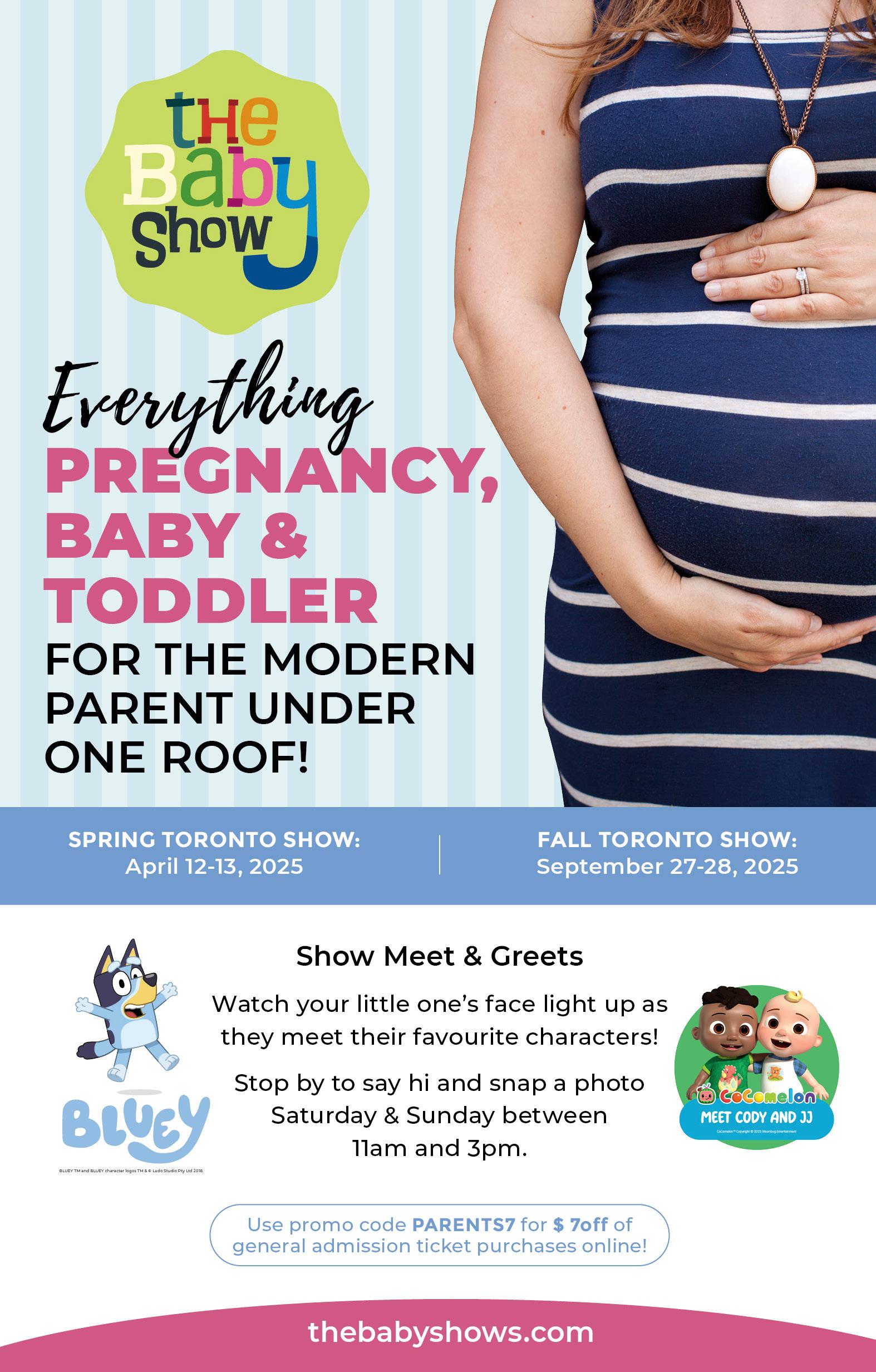
From January to June this year, we invited readers to take part in a national survey aimed at Canadian parents, in hopes that we could better understand the community we serve (which is you!). We were thrilled when more than 1000 parents from coast to coast took the time to weigh in, providing valuable insight into the needs and realities of families across the country. Here’s just a small snapshot of what we learned. For all of the survey results, check out parentscanada.com/surveysays.
60%
The percentage of parents who cite financial issues and the everyday slog of parenting as their biggest challenges

63% of respondents work full-time
1 in 2
Respondents say they don’t have access to affordable childcare
1 in 4 say they frequently feel lonely or isolated as a parent or caregiver
NEARLY 42% say having children has had a somewhat negative impact on their marriage or partnership
A WHOPPING 71%
say that it’s harder to be a parent now than when they were raised


Unsurprisingly, housing, food and childcare remain TOP OF THE LIST for financial concerns
